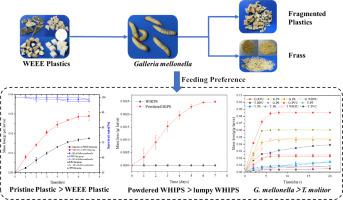Science of the Total Environment ( IF 8.2 ) Pub Date : 2021-10-16 , DOI: 10.1016/j.scitotenv.2021.151037 Ping Zhu 1 , Yilin Shen 1 , Xiaowei Li 1 , Xiankai Liu 1 , Guangren Qian 1 , John Zhou 2

|
Waste electrical and electronic equipment (WEEE) plastics not only pollute the environment, but are challenging to treat in an environmentally friendly manner. Biodegradation by insect larvae is potentially an eco-friendly method to treat WEEE plastics, but information about the feeding preference of insect larvae to WEEE plastics is lacking. In this study, a total of nine WEEE and pristine plastics were chosen to feed larvae of the following two insect species, i.e. Galleria mellonella and Tenebrio molitor. G. mellonella larvae significantly favor corresponding pristine plastics compared to two types of WEEE plastics, waste rigid polyurethane (RPU) and waste polystyrene (PS). One possible explanation is the increased chlorine or metals in the WEEE plastics measured using X-ray fluorescence spectrometer analysis. Scanning electron microscopy and Fourier transform infrared spectroscopy show that the destruction of physical structures and changes in surface functional groups were found in the two types of WEEE plastics in the larval frass, implying that the larvae partly biodegraded the plastics. Meanwhile, the powdered waste high impact polystyrene plastics (WHIPS) were ingested, but not the lumpy ones, indicating that the consumption by G. mellonella larvae is improved by the WHIPS physical modification. In addition, G. mellonella larvae presented the following decreasing preference for pristine plastics under individual-plastic-fed mode: RPU > phenol–formaldehyde resin > polyethylene (PE) > polypropylene > PS ≈ polyvinyl chloride; this is possibly due to differences in physical properties and chemical structures of the plastics; feeding preference of the larvae under multiple-plastics-fed mode is relatively consistent to that under individual-plastic-fed mode. Interestingly, the consumption by G. mellonella larvae of PE is higher than that of PS, while T. molitor larvae showed the opposite trend, implying that insect larvae have different plastics preference. The findings provide insights into biodegradation of WEEE plastics by insect larvae.
中文翻译:

昆虫幼虫对废弃电器电子设备塑料的取食偏好
废弃的电子电气设备 (WEEE) 塑料不仅会污染环境,而且很难以环保方式进行处理。昆虫幼虫的生物降解可能是一种处理 WEEE 塑料的环保方法,但缺乏关于昆虫幼虫对 WEEE 塑料的喂养偏好的信息。在这项研究中,总共选择了九种 WEEE 和原始塑料来喂养以下两种昆虫物种的幼虫,即大蜡螟和黄粉虫。大蜡螟与废硬质聚氨酯 (RPU) 和废聚苯乙烯 (PS) 两种 WEEE 塑料相比,幼虫明显偏爱相应的原始塑料。一种可能的解释是使用 X 射线荧光光谱仪分析测量的 WEEE 塑料中氯或金属含量增加。扫描电子显微镜和傅里叶变换红外光谱表明,在幼虫粪便中的两种 WEEE 塑料中发现了物理结构的破坏和表面官能团的变化,这意味着幼虫对塑料进行了部分生物降解。同时,粉状废弃高抗冲聚苯乙烯塑料(WHIPS)被摄入,但不是块状废物,表明WHIPS物理改性改善了大蜡螟幼虫的消耗。此外,G. mellonella幼虫在单独塑料喂养模式下对原始塑料的偏好呈以下递减趋势:RPU > 酚醛树脂 > 聚乙烯 (PE) > 聚丙烯 > PS ≈ 聚氯乙烯;这可能是由于塑料的物理性质和化学结构不同;多种塑料喂养模式下幼虫的取食偏好与单独塑料喂养模式下的相对一致。有趣的是,PE的G. mellonella幼虫的消耗量高于 PS,而T. molitor幼虫则表现出相反的趋势,这意味着昆虫幼虫对塑料的偏好不同。这些发现为昆虫幼虫对 WEEE 塑料的生物降解提供了见解。









































 京公网安备 11010802027423号
京公网安备 11010802027423号